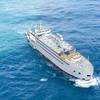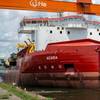It was on a routine patrol that the Colombian coast guard stumbled upon an eerie outpost amid the mangroves: a mini-shipyard where suspected drug traffickers were building submarines.
Perched on a makeshift wooden dry dock late last month were two 55-foot-long fiberglass vessels, one ready for launch, the other about 70% complete. Each was outfitted with a 350-horsepower Cummins diesel engine and enough fuel capacity to reach the coast of Central America or Mexico, hundreds of miles to the north.
The vessels had cargo space that could fit 5 tons of cocaine, a senior officer with the Colombian coast guard's Pacific command said in an interview.
The design featured tubing for air, crude conning towers and cramped bunk space for a crew of four, he added.
Over the last two years, Colombian authorities and the U.S. Coast Guard and Navy have seized 13 submarine-like vessels outfitted for drug running. The five seized by American authorities were en route to Mexico or Central America, each loaded with 3 to 5 tons of cocaine.
The seizures point to a security threat that goes beyond drug trafficking. Many law enforcement officials are concerned that U.S. ports and shorelines could be vulnerable to terrorist attacks using such crudely built submarines.
The boats have become increasingly sophisticated, evolving from huge tubes built to be towed by fishing or cargo boats to self-propelled vessels with ballast systems and communications equipment that leave no wake or radar profile as they glide just below the ocean surface.
The recent discovery in the Pacific Coast estuary about 25 miles south of the port city of Buenaventura reflects drug traffickers' growing use of such boats in the face of stepped-up operations by Colombian and U.S. anti-drug forces, experts say.
The subs were probably commissioned by the Revolutionary Armed Forces of Colombia, or FARC, in whose zone of influence the shipyard was situated, according to the officer, who asked not to be identified for security reasons. The FARC is thought to be Colombia's most powerful drug-trafficking organization.
Military officials here and in the United States say the war on drugs, financed by billions of dollars in U.S. aid, is forcing drug runners to undertake ever more ingenious methods of transporting cocaine from Colombia, which produces about 90% of the drug consumed in the United States.
Proponents insist that the campaign is producing concrete results. They cite a 24% increase in cocaine street prices this year as reported by the White House Office of National Drug Control Policy.
Improved surveillance and intelligence have led to spectacular busts this year, including the recent seizure in Manzanillo, Mexico, of 23 tons of cocaine hidden in a freight container aboard a Hong Kong-flagged vessel that had stopped in Buenaventura.
Meanwhile, critics of the war on drugs warn that the price increase, as in past instances, may prove only temporary.
In any event, the ever-changing tactics of Colombian drug traffickers targeting the lucrative U.S. market reflect a constant cat-and-mouse game.
The boats seized Oct. 28 are submarine-like, but officials here say a more accurate description is "self-propelled semi-submersible" craft because they do not dive and resurface like a true submarine.
Submarines are not new to drug trafficking, only more numerous, if the increase in seizures is any indication.
In what was the most spectacular bust involving a narco-submarine, police in September 2000 raided a warehouse near Bogota, the capital, and found a 100-foot-long submarine that was being built according to Russian plans.
The sub was thought to be a joint venture by Colombian and Russian drug mafias and would have been capable of carrying 10 tons of cocaine per trip had it been completed. Annual Colombian cocaine production is now estimated at 500 to 800 tons.
[Source: http://www.latimes.com]
Sponsored Content
Safer Starts Here: Build Ships, Protect Crews

July 2025
 Read the Magazine
Read the Magazine

 Read the Magazine
Read the Magazine
This issue sponsored by:

An Unclear Present Danger: The Future of Mine Warfare Is Deception
Subscribe for
Maritime Reporter E-News
Maritime Reporter E-News is the maritime industry's largest circulation and most authoritative ENews Service, delivered to your Email five times per week







